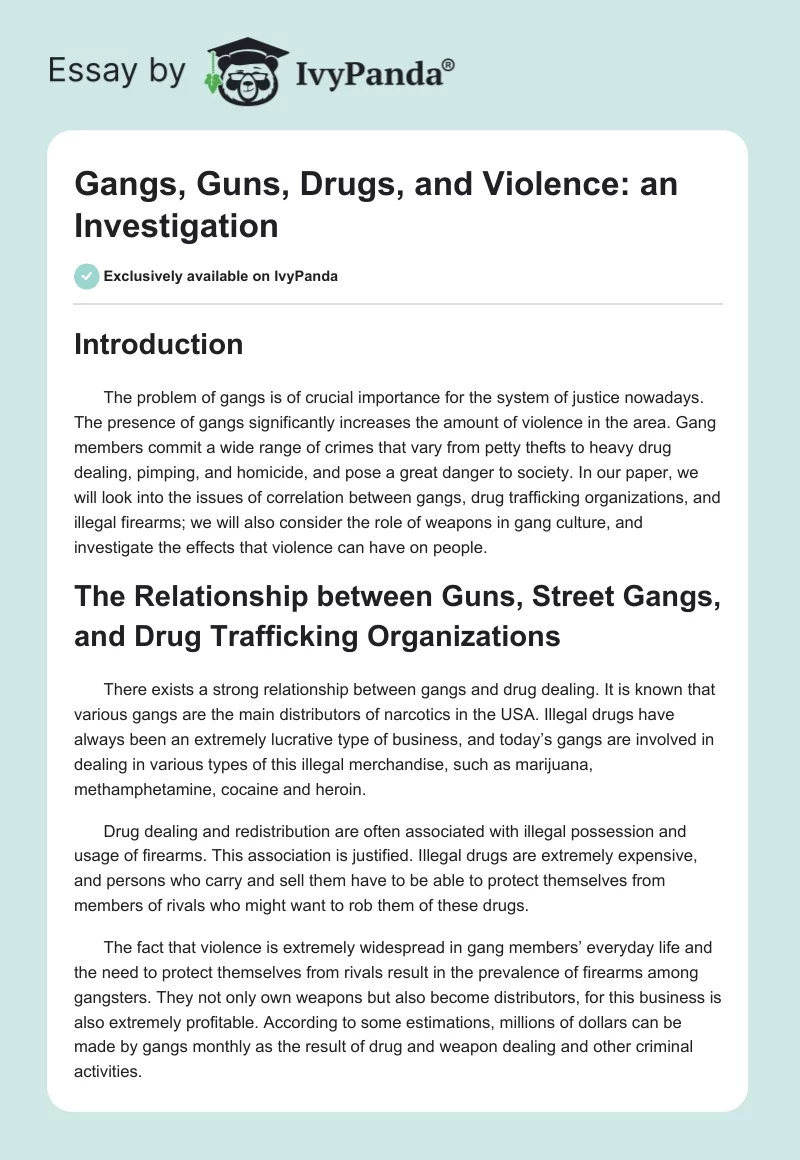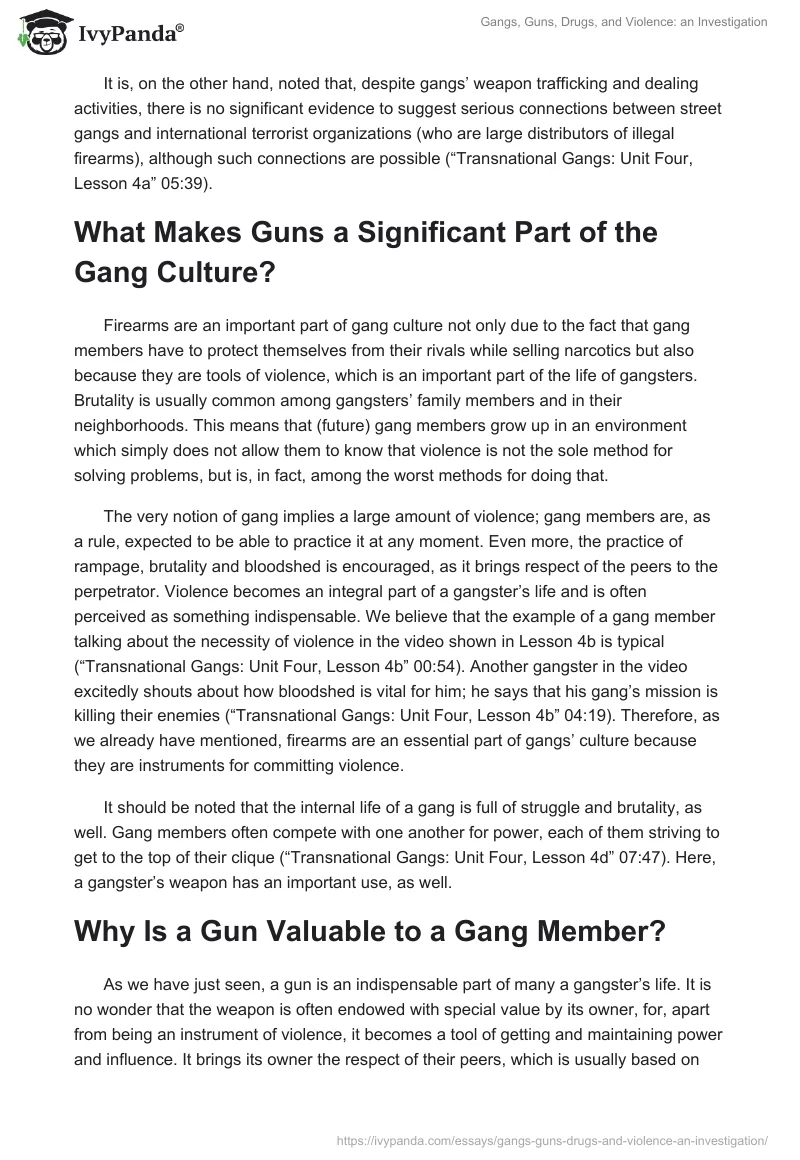Introduction
The problem of gangs is of crucial importance for the system of justice nowadays. The presence of gangs significantly increases the amount of violence in the area. Gang members commit a wide range of crimes that vary from petty thefts to heavy drug dealing, pimping, and homicide, and pose a great danger to society. In our paper, we will look into the issues of correlation between gangs, drug trafficking organizations, and illegal firearms; we will also consider the role of weapons in gang culture, and investigate the effects that violence can have on people.
The Relationship between Guns, Street Gangs, and Drug Trafficking Organizations
There exists a strong relationship between gangs and drug dealing. It is known that various gangs are the main distributors of narcotics in the USA. Illegal drugs have always been an extremely lucrative type of business, and today’s gangs are involved in dealing in various types of this illegal merchandise, such as marijuana, methamphetamine, cocaine and heroin.
Drug dealing and redistribution are often associated with illegal possession and usage of firearms. This association is justified. Illegal drugs are extremely expensive, and persons who carry and sell them have to be able to protect themselves from members of rivals who might want to rob them of these drugs.
The fact that violence is extremely widespread in gang members’ everyday life and the need to protect themselves from rivals result in the prevalence of firearms among gangsters. They not only own weapons but also become distributors, for this business is also extremely profitable. According to some estimations, millions of dollars can be made by gangs monthly as the result of drug and weapon dealing and other criminal activities.
It is, on the other hand, noted that, despite gangs’ weapon trafficking and dealing activities, there is no significant evidence to suggest serious connections between street gangs and international terrorist organizations (who are large distributors of illegal firearms), although such connections are possible (“Transnational Gangs: Unit Four, Lesson 4a” 05:39).
What Makes Guns a Significant Part of the Gang Culture?
Firearms are an important part of gang culture not only due to the fact that gang members have to protect themselves from their rivals while selling narcotics but also because they are tools of violence, which is an important part of the life of gangsters. Brutality is usually common among gangsters’ family members and in their neighborhoods. This means that (future) gang members grow up in an environment which simply does not allow them to know that violence is not the sole method for solving problems, but is, in fact, among the worst methods for doing that.
The very notion of gang implies a large amount of violence; gang members are, as a rule, expected to be able to practice it at any moment. Even more, the practice of rampage, brutality and bloodshed is encouraged, as it brings respect of the peers to the perpetrator. Violence becomes an integral part of a gangster’s life and is often perceived as something indispensable. We believe that the example of a gang member talking about the necessity of violence in the video shown in Lesson 4b is typical (“Transnational Gangs: Unit Four, Lesson 4b” 00:54). Another gangster in the video excitedly shouts about how bloodshed is vital for him; he says that his gang’s mission is killing their enemies (“Transnational Gangs: Unit Four, Lesson 4b” 04:19). Therefore, as we already have mentioned, firearms are an essential part of gangs’ culture because they are instruments for committing violence.
It should be noted that the internal life of a gang is full of struggle and brutality, as well. Gang members often compete with one another for power, each of them striving to get to the top of their clique (“Transnational Gangs: Unit Four, Lesson 4d” 07:47). Here, a gangster’s weapon has an important use, as well.
Why Is a Gun Valuable to a Gang Member?
As we have just seen, a gun is an indispensable part of many a gangster’s life. It is no wonder that the weapon is often endowed with special value by its owner, for, apart from being an instrument of violence, it becomes a tool of getting and maintaining power and influence. It brings its owner the respect of their peers, which is usually based on fear in the gang environment. Therefore, it is common for gangsters to admire their weapons very much.
The Effects of Violence on a Victim, a Witness, and a Perpetrator
There is no doubt that violence is harmful not only to victims but also to those who witness it or commit it. Let us look into each of these cases in turn.
Apart from bodily harm, violence can have a severe negative impact on the victim’s psychological condition and mental health. Having suffered from physical consequences of violence, the victim can suffer from the feeling of defenselessness, which results in constant fear and anxiety. When violence is repetitive and is combined with psychological pressure, it can result in an inferiority complex (for example, pimps who beat up their prostitutes often tell them that they are good for nothing, will never find another job, etc., which successfully helps exploit the girls and women for long years). The feeling of inferiority and other psychological problems often need to be balanced somehow; thus, people who constantly suffer from e.g. home violence are likely to practice violence against defenseless people, as well. Brutality can also lead to various psychiatric disorders in its victims.
The effect of violence on a witness is also, undoubtedly, harmful. If a person feels defenseless against perpetrators, witnessing violence can result in similar feelings of fear and anxiety. If the violence is extreme, it can also cause some psychiatric disorders even in this case; this is especially likely to occur in children. On the other hand, if a person does not feel defenseless against the opponent, they also might become “infected” and respond with violence; a phenomenon of an angry mob where one simply copies the behavior of the others is well-known.
And, finally, the effect of committing violence changes the perpetrator for the worse. To practice violence, one generally needs to have a certain inclination towards it, and the act of practicing it exacerbates this inclination. The usage of violence accustoms the offender to it and diminishes possible moral obstacles to brutality. Once the offender stops having any qualms about violence, they can experience the feeling of satisfaction and superiority over their victim, which may be quite addictive. It is also worth pointing out that extreme acts of violence (such as homicide) are often accompanied by the dehumanization of the victim, which makes the violence or the process of murder easier. Dehumanization is, for instance, very common among racist groups, during wars, and in other similar situations where violence is encouraged.
Therefore, violence is not only physically harmful to its victim; it is also mentally damaging to anyone who becomes involved in it in any way.
Conclusion
As we have seen, gangs are the main suppliers of narcotics in the USA. Violence is a native environment for gangs; weapons have become an important part of their culture. Having also considered the effects that violence can have on people, we can confirm our statement that gangs, illegal organizations which bask in violence, pose a great danger to society.
Works Cited
“Review: Week 4.” Online video clip. UCI Replay. The University of California, Irvine, n.d. Web. 2015.
“Transnational Gangs: Unit Four, Lesson 4a.” Online video clip. UCI Replay. The University of California, Irvine, n.d. Web. 2015.
“Transnational Gangs: Unit Four, Lesson 4b.” Online video clip. UCI Replay. The University of California, Irvine, n.d. Web. 2015.
“Transnational Gangs: Unit Four, Lesson 4d.” Online video clip. UCI Replay. The University of California, Irvine, n.d. Web. 2015.
“Transnational Gangs: Unit Four, Lesson 4e.” Online video clip. UCI Replay. The University of California, Irvine, n.d. Web. 2015.
“Transnational Gangs: Unit One, Lesson 16.” Online video clip. UCI Replay. The University of California, Irvine, n.d. Web. 2015.


